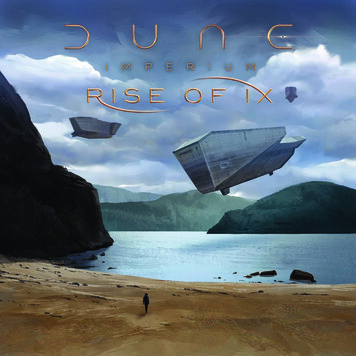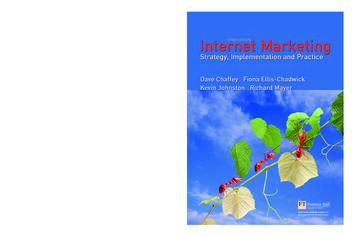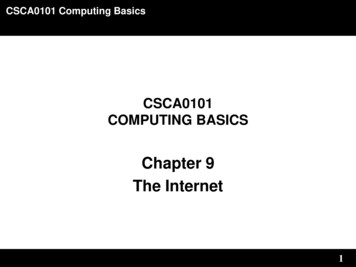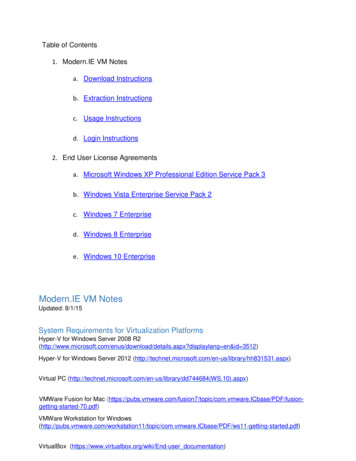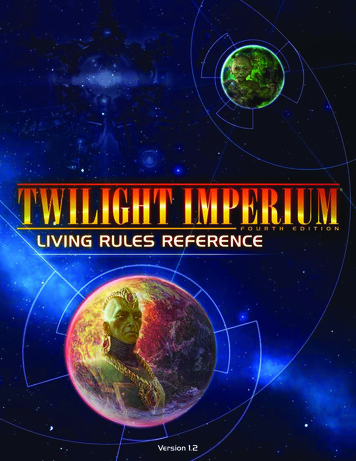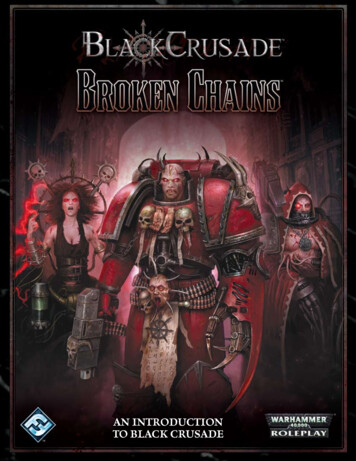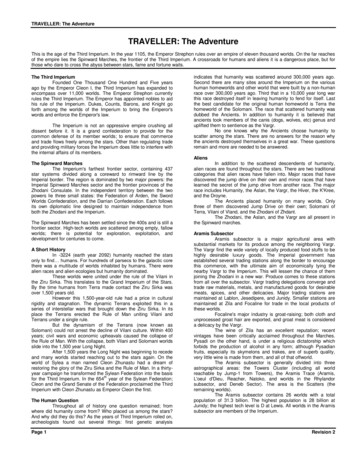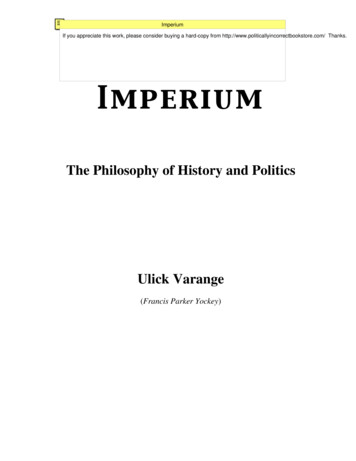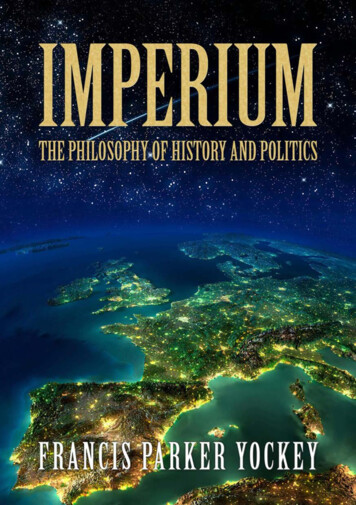
Transcription
Imperium
imperiumTHE PHILOSOPHY OF HISTORYAND POLITICSULICK VARANGE(Francis Parker Yockey)1948the Dot Connector Library, book 6
Also read:the dot connector library, book 1:Climategate, The Marijuana Conspiracy, Project Blue Beam (2010; 2015, 2nd edition)the dot connector library, book 2:Consensus Trance(2015; 2016, 2nd edition)the dot connector library, book 3:Think Or Be Eatenby Angie Riedel(2015; 2016, 2nd edition)the dot connector library, book 4:The Killing Gamesby Angie Riedel(2016)the dot connector library, book 5:The Iron Curtain Over Americaby John Beaty(2016)Copyright 1948 by Francis Parker YockeyAll rights reservedThis edition: March 2017Edited and published by Paul Bondarovskiunder the Creative Commons Attribution License isher’s website: www.wariscrime.comDesign, layout and cover 2017 by Paul Bondarovski
ContentsForeword 9THE 20TH CENTURY HISTORICAL OUTLOOKPerspective 55The Two Aspects of History 67The Relativity of History 71The Meaning of Facts 75The Demise of the Linear View of History 79The Structure of History 87Pessimism 94The Civilization-Crisis 105Darwinism 112Marxism 122Freudianism 132The Scientific-Technical World-Outlook 140The Imperative of Our Age 150THE 20TH CENTURY POLITICAL OUTLOOKIntroduction 163The Nature of Politics 166The War-Politics Symbiosis 175The Laws of Totality and Sovereignty 189The Pluralistic State 193The Law of Constancy of Inter-Organismic Power 196The Law of Constancy of Intra-Organismic Power 199The Political Pluriverse 2025
ContentsLeague of Nations 206The Inner Aspect of the Law of Sovereignty 210Political Organisms and War 217The Law of Political Plenum 223The Law of Protection and Obedience 227Internationale 231The Two Political Anthropologies 237Liberalism 241Democracy 256Communism 262Association and Dissociation of Forms of Thought and Action 265CULTURAL VITALISM. (A) CULTURE HEALTHIntroduction 277The Articulation of a Culture 280Tradition and Genius 290Genius 294Genius and the Age of Absolute Politics 299Race, People, Nation, State 302Subjective Meaning of Race 319Horizontal Race v. Vertical Race 326Race and Policy 329People 340Nation 350Nation and History 355Nation and Rationalism 359Nation in the 20th Century 368State 373CULTURAL VITALISM. (B) CULTURE PATHOLOGYCulture Pathology 387Culture Parasitism 393Culture-Distortion 417Culture Retardation as a Form of Culture Distortion 425
ContentsCulture Distortion Arising from Parasitic Activity 430AMERICAIntroduction 455The Origins of America 457The American Ideology 461The War of Secession, 1861–1865 468The American Practice of Government 473The History of American Imperialism 481American Imperialism in the Age of Annihilation Wars 490The American Revolution of 1933 500World-Outlook 508The Negro in America 517Culture-Retardation in America 522Propaganda 528The Conduct of American Foreign Affairs from 1933 538The Future of America 551THE WORLD SITUATIONThe Political World 563The First World War 566The Second World War 572Russia 579Japan 587America 591The Terror 596The Abyss 606Imperium 610About the Author 615Index 617
To the hero of the Second World War
Was mich nicht umbringt, macht mich stärker.NIETZSCHE
ForewordThis book is different from other books. First of all, it is onlyin form a book at all. In reality, it is a part of the life of action.It is a turning-point in European history, a late turning-point,but a real one. There is nothing original in the content of thisbook, the book itself only is original. The craze for originalityis a manifestation of decadence, and the decadence of Europe isthe ascendancy of the Barbarian.This is the first of a line of works—the political literature ofEurope. Heretofore all political works on the imperative sidehave been addressed to one nation of Europe alone. Amongother things, this book marks the end of Rationalism. It does notbring it about—not books but only the advance of History canaccomplish anything of that sort—it merely rings its funeral knell.Thus the imperative side of Life returns to its pristine Source, thewill-to-power. Henceforth there will be no discussion of actionin terms of abstract thought.This is addressed to all Europe, and in particular to theculture-bearing stratum of Europe. It summons Europe to aworld-historical struggle of two centuries’ duration. Europe willpartake in this struggle either as a participant, or as the booty formarauding powers from without. If it is to act, and not merelyto suffer in this series of gigantic wars, it must be integrated,and there is only one way this can occur. The Western Culture11
Forewordis suffering from disease, and the prolongation of this disease isthe prolonging of Chinese conditions in Europe.The word Europe changes its meaning: from now on it meansthe Western Civilization, the organic unity which created as phasesof its life the nation-ideas of Spain, Italy, France, England andGermany. These former nations are all dead; the era of politicalnationalism has passed. This has not happened through logicalnecessity, but through the organic advance of the History ofthe West. It is this organic necessity which is the source of ourimperative, and of the integration of Europe. The significance ofthe organic is that its alternatives are either to do the necessaryor to sicken and die.The present chaos—1948—is directly traceable to the attemptto prevent the integration of Europe. As a result, Europe is in aswamp, and extra-European forces dispose of former Europeannations as their colonies.In this book are the precise, organic foundations of the Westernsoul, and in particular, its Imperative at this present stage. EitherEurope will become totally integrated, or it will pass entirely outof history, its peoples will be dispersed, its efforts and brains willbe at the disposal forever of extra-European forces. This is shownherein, not by abstract formulae and intellectualized theories, butorganically and historically. The conclusions therefore are notarbitrary, not a subject for choosing or rejecting, but absolutelycompelling to minds which wish to take part in affairs. The realauthor is the Spirit of the Age, and its commands do not admitof argumentation, and their sanction is the crushing might ofHistory, bringing defeat, humiliation, death and chaos.I condemn here at the outset the miserable plans of retardedsouls to “unite” Europe as an economic area for purposes of exploitation by and defense of the Imperialism of extra-Europeanforces. The integration of Europe is not a subject for plans, but forexpression. It needs but to be recognized, and the perpetuationof nineteenth century economic thinking is entirely incapable12
Forewordhere. Not trade and banking, not importing and exporting, butHeroism alone can liberate that integrated soul of Europe whichlies under the financial trickery of retarders, the petty-stateismof party-politicians, and the occupying armies of extra-Europeanforces.The imperative integration of Europe takes the form of unityof People, Race, Nation, State, Society, Will—and naturally also—economy. The spiritual unity of Europe is there, its liberation willautomatically allow the full blooming of the other phases of theorganic unity, which all flow from the spiritual.And thus, this book is a renewal of a war-declaration. It asksthe traitors to Europe, the miserable party-politicians whosetenure of office is dependent upon their continued serviceabilityto extra-European forces, “Did you think it was over? Do youthink that your misery and shame will remain securely foreveron a world-stage which has seen true heroes upon it? In the warwhich you let loose, you taught men how to die, and therebyyou have freed a spirit which will engulf you next, the Spirit ofHeroism and Discipline. There is no currency that can buy thisspirit, but it can overcome any currency.”Lastly, this book is itself the first blow in the gigantic war for theliberation of Europe. The prime enemy is the traitor within Europe,who alone makes possible the starving and looting of Europe bythe outer forces. He is the symbol of Chaos and Death. Betweenhim and the spirit of the twentieth century is unremitting war.Brittas Bay, January 30, 194813Ulick Varange
THE 20th CENTURYHISTORICALOUTLOOK“Thus, as we do nothing but enact history, we say little but recite it: nay,rather, in that widest sense, our whole spiritual life is built thereon. For,strictly considered, what is all knowledge too but recorded experience,and a product of history; of which, therefore, reasoning and belief, noless than action and passion are essential materials?”Carlyle“The individual’s life is of importance to none besides himself: thepoint is whether he wishes to escape from history or give his life for it.History recks nothing of human logic.”Spengler15
PerspectiveFar out in exterior darkness where no breath stirs, no lightshines, and no sound is heard, one can glance toward this spinningearth-ball. In the astral regions, illumination is of the soul, henceall is dark but this certain star, and only a part of it is aglow. Fromsuch a distance, one can obtain an utterly untrammeled view ofwhat is transpiring on this earth-ball. Drawing somewhat closer,continents are visible; closer yet, population-streams. One focalpoint exists whence the light goes forth in all directions. It is thecrooked peninsula of Europe. On this tiny pendant of the greatland-mass of the earth-ball, the greatest intensity of movementexists. One can see—for out here the soul and its emanationsare visible—a concentration of ideas, energy, ambition, purpose,expansiveness, will-to-form. Hovering above Europe we can seewhat never before was so clearly visible—the presence of a purelyspiritual organism. A close look reveals that the light stream isnot flowing from the surface of Europe upward into the nightsky, but downward from the hitherto invisible organism. This isa discovery of profound and revolutionary importance, whichwas only vouchsafed to us by reason of our complete detachmentfrom terrestrial events in the outer void, where spirit is visibleand matter visible, only by reason of the light from the spirit.17
THE 20TH CENTURY HISTORICAL OUTLOOKMore discoveries follow: on the other side are two islands, smallin comparison with the land-mass. The pale glow diffused overisolated parts of these two islands is seen at once to be a reflectionfrom the other side.What is this supra-terrestrial phenomenon? Why does it hoverover Europe in particular? What is the relationship between itand the human material under it? The latter is shaped up intointricately formed pyramidal structures. Ranks are formed. Movements proceed along channels of labyrinthine complexity. Personsstand to one another in defined relationships of command andobedience. Apart from this tiny peninsula, the human currentsare horizontal, swirling, eddying like the water in the streams,the currents in the ocean, the herds on the vast plains. It is, then,the spirit-organism which forms and impresses the populationof the peninsula into their intricate organic shapes.With what can we compare this being, which could not be seenby us while we were earth-bound? It is alone at present.But out here we have the freedom of time as well as the freedomof space. We are allowed to look upon a hundred generationsas the earth-bound look upon the life-span of a fruit-fly. In oursearch for something similar to the spirit-organism we have seen,we go back two hundred generations. The ball is the same, but isin almost complete darkness. Things are almost indistinguishable; matter has not passed through the alembic of spirit, and isnot apprehensible. A glance backward reveals a continuation ofthe void. We let a few generations pass in a moment, and spiritbegins to make itself felt. A feeble, but promising, glow appearsin northeast Africa. Then another, a thousand miles to thenortheast, in Mesopotamia. They take names, Egypt, Babylonia.The time is around 3000 B.C. They increase in intensity andthe first thing clear in each case is armies marching against theouter populations, who are felt as the barbarian. These spiritualorganisms do not mix—their higher frontiers are sharp and clear;each being has its own hue, which adheres to it. Each organism18
Perspectiveseizes the human material in its landscape and impresses theminto its service. First it gives them a common World-Idea, thenit refines this into nations, each nation embodying a separateidea of the higher organism. A nobility and priesthood ariseto embody different aspects of the idea. The populations arestratified and specialized, and the human beings live out theirlives and destinies in a way entirely subordinate to the higherorganism. The latter compels these humans with ideas. Only asmall spiritual stratum of each human population is adapted tothis kind of compulsion, but those who belong to it remain inthe service of the idea, once it is felt. They will live and die forit, and in the process they determine the destinies of the population whence they spring. These ideas—not mere abstractions,strings of concepts, but living, pulsating, wordless necessitiesof being and thinking—are the technic by which these higherbeings utilize human beings for their purposes. Religions ofhigh complexity of feeling and rationale, forms of architecture,conceived in the spirit of that religion and put into its service,lyric poetry, pictorial art, sculpture, music, orders of nobility,orders of priesthood, stylized dwellings, stylized manners anddress, rigid training of the young up to these developments toperpetuate them, systems of philosophy, of mathematics, ofknowledge, of nature, prodigious technical methods, giant battles,huge armies, prolonged wars, energetic economics to support thiswhole multifarious structure, intricately organized governmentsto infuse order into the nations created by the higher being actingon the different types of human material—these are some of thefloraison of forms which appear in these two areas. Each formis different in Egypt from the corresponding form in Babylonia.If an idea is taken over, it is only apparently adopted; actually itis misunderstood, re-formed, and adapted to the proper soul.But the higher being approaches a crisis. It has expended itselfin this earth-transforming process. It shudders, it apparentlyweakens, it palpitates—chaos and anarchy threaten its terrestrial19
THE 20TH CENTURY HISTORICAL OUTLOOKactualizations—forces outside gather to strike it down and wipeout its grand creations. But it rouses itself, it puts forward itsgreatest effort of all—no longer in the creation of inward things,arts, philosophy, theories of life, but in the formation of the purelyexternal apparatus of power: strict governments, giant armies,industry to support them, fleets of ships for war, legal systems toorganize and order the conquests. It expands across areas neverbefore investigated or even known, it unifies all of its propernations into one, which gives its name to the rest and leads themon to the last great expansive effort.The same great rhythm is observable in each of them. As onewatches, the two lights die down from their splendid hues toan ever-paler earth-light. They go out slowly, leaving a glow ofmemory and legend in the minds of men, and with their last greatcreations lying in the widened landscape—Imperium.Outside these two areas, the rest of the earth has remainedunchanged. The human bands are distinguishable from theherding-animals only by a primitive culture, and a more intricate economy. Otherwise their existence-forms are devoid ofsignificance. The primitive cultures are the sole thing existingabove the plane of economics, in that they attribute symbolicsignificance to natural occurrences and human conduct. But thereis nothing in these movements resembling the High Cultureswhich transformed the entire appearance of the Egyptian andBabylonian landscapes for almost forty generations from theirfirst beginning until the last sinking.Physical time flows on and centuries pass in darkness. Then,precisely as in Egypt and Babylonia, but again of a different hue,and to different music, a light appears over the Punjab. It becomesbright and firm. The same wealth of forms and significant happenings work themselves out as in the earlier two organisms. Itscreations are all in the highest degree individual, as different fromits two predecessors as they were vis-a-vis one another, but theyfollow the same grand rhythms. The same multi-colored pageant20
Perspectiveof nobles and priests, temples and schools, nations and cities, artsand philosophies, armies and sciences, letters and wars, passesbefore the eye.IIBefore this high culture was well on its way, another had startedto actualize itself in the Hwang-Ho valley in China. And then afew centuries later, about 1100 B.C. in our way of reckoning, theClassical Culture begins on the shores of the Aegean. Both ofthese cultures have the stamp of individuality, their own way ofcoloring and influencing their terrestrial creations, but both aresubject to the same morphology as the others observed.As this Classical Culture draws to its close, around the timeof Christ, another one appears in a landscape subjugated bythe Classical in its last expansive phase—Arabia. The fact of itsappearance precisely here makes its course an unusual one. Itsforms are inwardly as pure as those of all the other Cultures,inwardly it borrows nothing any more than they did—but it wasinevitable that the material contiguity of landscape, temporalsuccession, and contact with the civilized populations of the olderorganism would influence the new soul to take over the wealth ofclassical creations. It was subjugated to them only in a superficialway however, for into these old bottles it poured its new wine.Through selection, reinterpretation, or ignoring, it expressed itsown soul despite the alien forms. In its later, expansive phase, thisculture embraced European Spain as the Western Caliphate. Itslife span, its end form, its last great crisis—all followed the sameorganic regularity as the others.Some five centuries later the now familiar manifestations ofanother High Culture begin in the remote landscapes of Mexicoand Peru. It is to have the most tragic destiny of any we haveyet seen. Around 1000 A.D. the European Culture is meanwhileborn, and at its very birth shows itself to be distinguished fromthe others by the extraordinary intensity of its self-expression, by21
THE 20TH CENTURY HISTORICAL OUTLOOKits pushing into every distance both in the spiritual realm, and inthe physical. Its original landscape was even of an extent manytimes the size of its predecessors, and from this base, in its middlelife, it enters upon an Age of Discovery, in which it finds for itselfthe very frontiers of the earth-ball, and converts the world intothe object of its politics. Its Spanish representatives in the twowarrior bands of Cortés and Pizarro discovered the Civilizationof Mexico and Peru, then in its very last stage of refinement of thematerial life. The two grand Empires of Mexico and Peru, withsocial forms, economico-political organization, transportation,communication, city life, all developed to the utmost limits for thisparticular soul made the invading Spaniards seem like mere naivebarbarians. But the technical disinterestedness of these empiresleft them helpless before the few cannon and horses of the invaders. The last act of this Culture-drama is its obliteration in a fewyears by the invaders from another world. This consummation isinstructive as to the attention that the World-Spirit pays to humanvalues and feelings. What soothsayer would have dared to tell thelast Aztec Emperor, surrounded with the pomp of world-historicalsignificance, clothed with the power of the world, that in a shorttime the jungle would reconquer his cities and palaces, that hisarmies and systems of control of his world-Empire would vanishbefore the onslaught of a few hundred barbarians?Each Culture-soul is stamped with individuality; from theothers it takes nothing, and to them it gives nothing. Whatever ison its frontiers is the enemy, whether primitive or Culture-populations. They all are barbarians, heathens, to the proper culture,and no understanding passes between them. We saw the Westernpeoples prove the lifeworthiness of the European culture by theircrusades against the highly civilized Saracens, Moors, and Turks.We saw the Germanic populations in the East and their Visigothicbrothers in the South push the barbarian Slavs and the civilizedMoors continually back during the centuries. We saw Westernships and Western armies make the whole world into the object22
Perspectiveof booty for the West. These were the relations of the West tothat and those outside.Within the Culture arose Gothic Christianity, the transcendent symbols of Empire and Papacy, the Gothic cathedrals, theunlocking of the secrets of the world of the soul and the world ofnature in monastery cells. The Culture-soul shaped for its ownexpression the nations of the West. To each it gave individuality,and at the last, each thought it was a Culture in itself, instead ofbeing a mere organ of a Culture. Cities grew out of the hamlets ofGothic times, and from the cities grew intellect. The old problemof the relation of Reason and Faith, the central problem of earlyScholastic, is apparently being slowly decided in these cities infavor of the Supremacy of Reason. The nobility of Gothic times,the masters of the earth who had no superior unless they voluntarily recognized him, become subject to an idea—the State.Life slowly externalizes: political problems move into the center;new economic resources are developed to support the politicalcontests; the old agricultural economy metamorphoses into anindustrial economy. At the end of this path stands a ghostly andterrifying Idea: Money.Other Cultures also had seen this phenomenon appear at thesame stage and grow to similar dimensions. Its slow growth inimportance proceeds pari passu with the gradual self-assertionof Reason against Faith. It reaches its highest point with the Ageof Nationalism, when the parts of the Culture tear one another tobits, even as outer dangers loom threateningly. At its highest point,Money, allied with Rationalism, contests for the supremacy overthe life of the Culture with the forces of State and Tradition, Societyand Religion. In our brief visit to interstellar space, we found theposition of detachment whence we could see this grand life-drama unfold itself seven times in seven High Cultures, and we saweach of the seven surmount the last great crisis of two centuries’duration. The Mexican-Peruvian Civilization overcame the innercrisis only to fall before marauders appearing out of the blue sea.23
THE 20TH CENTURY HISTORICAL OUTLOOKThe great crisis of the West set in forcefully with the FrenchRevolution and its consequent phenomena. Napoleon was thesymbol of the transition of Culture into Civilization—Civilization,the life of the material, the external, of power, giant economies,armies, and fleets, of great numbers and colossal technics, overCulture, the inner life of religion, philosophy, arts, dominationof the external life of politics and economics by strict form andsymbolism, strict restraint of the beast-of-prey in man, feelingof cultural unity. It is the victory of Rationalism, Money and thegreat city over the traditions of religion and authority, of Intellectover Instinct.We had seen all this in the previous high cultures as theyapproached their final life-phase. In each case the crisis hadbeen resolved by the resurgence of the old forces of Religion andAuthority, their victory over Rationalism and Money, and the finalunion of the nations into an Imperium. The two-century-longcrisis in the life of the great organism expressed itself in giganticwars and revolutions. All the Cultural energy that had previously gone into inner creations of thought, religion, philosophy,science, art-forms, great literature, now goes into the outer lifeof economics, war, technics, politics. The symbolism of powersucceeds to the highest place in this last phase.But at this point, we are suddenly back on the surface of theearth. No longer detached, we must participate in the greatCulture-drama, whether we will or no. Our only choice is toparticipate as subject or as object. The wisdom that comes fromthe knowledge of the organic nature of a High Culture givesus the key to the events transpiring before our eyes. It can beapplied by us, and our action can thereby become significant, asdistinguished from the opportunistic and old-fashioned policyof stupidity which would try to turn the Western Civilizationback in its course because stupid heads are incapable of adjustingthemselves to new prevailing ideas.24
PerspectiveIIIWith the knowledge of the organic nature of a High Culture,we have achieved an unparalleled liberation from the dross ofmaterialism which hindered hitherto the glimpse into History’sriddle. This knowledge is simple, but profound, and is thereforeshut off from the inward appreciation of all but the few. In its trainflow all the consequences of the necessary historical outlook of thecoming times. Since a Culture is organic, it has an individuality,and a soul. Thus it cannot be influenced in its depths from anyoutside force whatever. It has a destiny, like all organisms. It has aperiod of gestation, and a birth-time. It has a growth, a maturity,fulfillment, a down-going, a death. Because it has a soul, all of itsmanifestations will be impressed by the same spiritual stamp, justas each man’s life is the creation of his own individuality. Becauseit has a soul, this particular culture can never come again after ithas passed. Like the nations it creates to express phases of its ownlife, it exists only once. There will never be another Indian culture,Aztec-Mayan Culture, Classical Culture, or Western Culture,any more than there will be a second Spartan nation, Romannation, French or English nation. Since a Culture is organic, ithas a life-span. We observed this life span: it is about thirty-fivegenerations at highest potential, or about forty-five generationsfrom its first stirrings in the landscape until its final subsiding.Like the life span of organisms, it is no rigid thing. Man has a lifespan of seventy years, but this term is not rigid.The High Cultures belong at the peak of the organic hierarchy:plant, animal, man. They differ from the other organisms in thatthey are invisible, or in other words, they have no light-quality. Inthis they resemble the human soul. The body of a High Culture ismade up of the population streams in its landscape. They furnishit with the material through which it actualizes its possibilities.The spirit which animates these populations shows the life-phaseof the Culture, whether youthful, mature, or at the last fulfillment.Like each man, a Culture has ages, which succeed one another with25
THE 20TH CENTURY HISTORICAL OUTLOOKrhythmic inevitability. They are laid down for it by its own organiclaw, just as the senility of a man is laid down at his conception.This quality of direction we call Destiny. Destiny is the hallmark ofeverything living. Destiny-thinking is the type of thought whichunderstands the living, and it is the only kind which does. Theother method of human thought is that of Causality. This methodis inwardly compulsory in dealing with inorganic problems oftechnics, mechanics, engineering, systematic natural philosophy.It finds the limits of its efficacy there, however, and is grotesquewhen applied to Life. It would tell us that youth is the cause ofmaturity, maturity of old age, that the bud is the cause of the fullblown flower, the caterpillar the cause of the butterfly.The Destiny-Idea is the central motive of organic thinking. Ifanyone thinks it is merely an invisible causality, he understandsit not. The idea of Causality is the central motive of systematic,or inorganic thinking. The latter is scientific thinking. It aimsat subjugation of things to understanding; it wishes to name everything, to make outlines distinct, and then to link phenomenatogether by classification and causal linkage. Kant is the heightof this type of thinking, and to this side of Western philosophybelong also Hume, Bacon, Schopenhauer, Hamilton, Spencer,Mill, Bentham, Locke, Holbach, Descartes. To the organic sidebelong Machiavelli, Vico, Montaigne, Leibniz, Lichtenberg, Pascal,Hobbes, Goethe, Hegel, Carlyle, Nietzsche and Spengler, thephilosopher of the twentieth and twenty-first centuries.Scientific thinking is at the height of its power in the realm ofmatter, that which possesses extension, but no direction. Materialhappenings can be controlled, are reversible, produce identicalresults under identical conditions, are recurrent, can be classified,can be successfully comprehended as though they are subject toan a priori, mechanical, necessity, in other words, to Causality.Scientific thinking is powerless in the domain of Life, for itshappenings are uncontrollable, irreversible, never-recurring,unique, cannot be classified, are unamenable to rational treat26
Perspectivement, and possessed of no external, mechanical necessity. Everyorganism is something never seen before, that follows an innernecessity, that passes away, never to reappear. Every organismis a set of possibilities within a certain framework, and its life isthe process of actualization of these possibilities. The techniqueof Destiny-thinking is simply living into other organisms tounderstand their life-conditions and necessities. One can thenapprehend what must happen.The word Fate is an inorganic word. It is an attempt to subjugate Life to an external necessity; it is of religious provenance,and religion comes from the causal type of thinking. There
Climategate, The Marijuana Conspiracy, Project Blue Beam (2010; 2015, 2nd edition) the dot connector library, book 2: Consensus Trance (2015; 2016, 2nd edition) the dot connector library, book 3: Think Or Be Eaten by Angie Riedel (2015; 2016, 2nd edition) the dot connector
